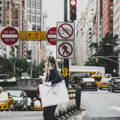The New Bicycle Blueprint: NYC’s Big Plans
Written by: Rémy Rossi | July 15, 2025 | Time to read 6 min
What if biking in NYC was safer, more seamless, and totally enjoyable? That’s the vision behind the New Bicycle Blueprint.

More about the Author: Remy Rossi
Rémy Rossi is a bike writer, mechanic, and educator who got his start in community-based bike shops and co-ops. With a decade in the industry, he still wrenches on bikes when he can and plays bike polo on a fixie.

There are some big plans in the works to transform the US’s largest city into a world-class bicycling metropolis. The New Bicycle Blueprint— developed by the Transportation Alternatives non-profit— lays out the steps to improve cycling in New York City, supported by comprehensive data. These reports are the ones I love to read; there’s convincing evidence, educational graphics, practical strategies, and ambitious goals for the Big Apple. If you’re a bike commuter in NYC or just an urban planning nerd, this recently released report is mandatory summer reading!
In this blog, I’ve picked out the highlights and will drop my own reflections on the report, but I highly encourage you to read the entire New Bicycle Blueprint— it’s an enjoyable and informative read with excellent data visualizations and maps.
Cycling growth in New York City

The blueprint for NYC’s cycling future is building on an already stable foundation— but, of course, there’s serious room for improvement. New York City has witnessed booming bike ridership in recent years and has made decent strides in infrastructure. For example, between 2007 and 2024, the number of people who commuted by bike tripled, and around 13% of all New Yorkers used a Citi Bike at some point last year.
There is a growing network of protected bike lanes, and studies have found that for every mile of protected bike lanes added to the streets of New York, daily bike trips increased by 1,100, and nearly 20% of them replaced car trips. Around 42% of adults in New York City ride a bike at least once a year, 16% of adults ride a bike at least once a week, and 24% at least once a month. These growing numbers show that cycling in NYC has finally become a mainstream method for New Yorkers to get around.
The goal for 2030
And this is a worthwhile goal because of the huge benefits from increased cycling, including “cleaner air, safer streets, longer life expectancies, less congested roads, improved public health, substantial cost savings, and even fewer potholes”. And all those things have been on my Christmas list for quite a while.
The problems with NYC’s streets & bike network

And we’re talking protected bike lanes here, not just street paint for cycle lanes, because it’s protected bike lanes that actually increase safety and encourage ridership. Data shows that, over the past ten years in NYC, nearly every person who was killed on a bicycle was killed on a street without a protected bike lane.
Beyond the simple lack of quality bike lanes across the city, equity is another huge problem. Low-income neighborhoods have fewer bike lanes and suffer from higher rates of cyclist traffic deaths— the report states that, “43% of cyclist fatalities and 45% of serious injuries occur in high-poverty census tracts that make up just 28% of the city.”
Access and proximity to protected bike lanes are also an issue for New Yorkers. Almost five million residents live more than ¼ mile from one. Most people in the city say that “feeling unsafe” was the main reason they don’t ride a bike— the second most common reason is the lack of safe places to park their bike.
Ok, so here’s the plan

Policy recommendations
- Build a connected network of protected bike lanes.
- Advance generational infrastructure projects that support and accommodate cycling growth.
- Maintain the bike network as a high-quality resource over time.
- Facilitate reliable access to a bicycle for everyone who wants or needs one.
- Implement policies that encourage people to ride bikes.

And there’s a huge opportunity to support communities of color and women via investment in cycling infrastructure, since they are such frequent riders of Citi Bike. The majority of Citi Bike riders are people of color, and nearly half of the women who ride a bike in New York use Citi Bike.
Key Takeaways
- NYC wants to hit 1 million daily bike trips by 2030, by building a connected, protected bike lane network accessible to all residents.
- Equity is a core goal: Low-income neighborhoods, women, and people of color stand to gain the most from better infrastructure and e-bike access.
- Safety and access are everything: Protected lanes, safe parking, and e-Bike subsidies are central to making biking a viable choice for everyone.


